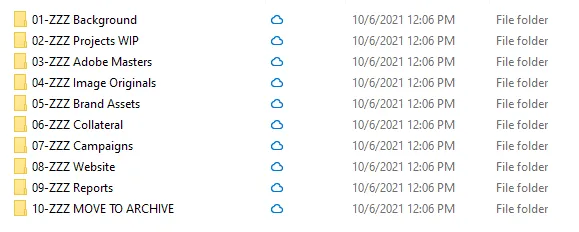Efficient File Management: 7 Key Strategies for Organizational Success
June 20, 2024

Optimizing Computer File Management: A Strategic Approach
In the era of digital abundance, our computers and servers often accumulate outdated, redundant, and unnecessary files. While expanding storage capacity seems like a quick fix, the true cost of poor file management extends beyond hardware expenses. Consider these factors:
- Productivity Loss: Endless file searches waste valuable time.
- Outdated Information: Relying on obsolete files poses risks.
- Backup Oversights: Neglected files may escape routine backups.
- Permissions Challenges: Sharing and security issues arise.
To address this, establish robust IT Policies and Procedures for file management. Encourage standardized practices across your organization. As your company grows, a cohesive approach ensures efficiency and minimizes headaches.
Strategic File Storage and Backup Practices
- Choose the Right Location:
- Avoid storing files solely on employees’ computers or laptops, as they are typically not backed up.
- Consider these options:
- OneDrive for Business: Part of Microsoft 365 subscription.
- Google Drive: Included in Google Workspace.
- On-Premise Servers: Traditional server-based storage.
- Cloud Solutions: Dropbox, Box, AWS, Adobe Cloud, iCloud Drive, and others.
- Confused about SharePoint vs. OneDrive? You’re not alone!
- Backup and Recovery:
- While the cloud automatically backs up files, be aware of the limited retention period.
- Implement robust backup procedures to safeguard critical data.
- Email Attachments vs. Shared Boxes:
- Instead of emailing attachments, explore shared email boxes and distribution lists for efficient collaboration.
2. Optimizing File Access and Security Roles
As a Michigan-based IT services company, data security is our top priority. When structuring file folders, consider organizing them based on job functions:
- Accounting
- Consulting
- Engineering
- Human Resources
- Marketing
- Production
- Sales
Within each category, create relevant sub-folders. Collaborate with your team to fine-tune this structure—whiteboards are excellent tools for visualizing the organization!
3. Optimizing File Organization and Lifecycle
When structuring your file hierarchy, consider the following strategies:
- Accounting:
- Begin with sub-folders by year. After closing the financial year, move files to an archive and then to digital cold storage.
- Marketing:
- Create sub-folders based on campaigns or file types. Consider separate folders for program files, images, and specific document types.
- Sales or Consulting:
- Organize sub-folders by client name, placing projects within those sub-folders.
- Consistent Numbered Hierarchy:
- Use numerical labels to maintain consistency across folders.
Remember, thoughtful organization ensures efficient access and secure data management! 🗂️💡

4. Effective File Naming Conventions
Customizing file naming conventions is essential for every company. Our preferred approach is to create descriptive names that transition from general to specific. Consider including a document legend in your IT policies and procedures to help users interpret file names.
For instance, in a website development context, adopt a format like this:
- CLIENT-PROJECT-FILE-VERSION-REVIEWER
Example file name: ‘ABC-WEB-Services-V3-RJS.docx’
This structure simplifies version tracking and ensures clarity during approval processes
5. Streamlining Document Templates for Efficient Collaboratio
In a previous discussion, we highlighted the simplicity of using Microsoft Word Templates to create polished, consistent documents. However, managing templates across employee hard drives requires additional steps to facilitate widespread sharing and updates.
Here’s our recommended approach:
-
Master Template: Maintain an uneditable “master” template in a shared location. Employees can download this template as needed.
-
Collaboration Version: Store another editable version on a Team or SharePoint site. Team members can enhance and refine the template within their workgroup.
-
IT Support: Your IT Provider or Microsoft 365 Administrator can distribute templates to individual users.
By implementing this strategy, you’ll enhance efficiency and ensure uniformity in your document creation process.
6. Prioritizing Sensitive Data Protection
In the digital landscape, many companies handle electronic information containing sensitive data—health records, personal contacts, social security numbers, and passwords. Regardless of legal mandates, safeguarding this information is critical. Neglecting security measures can lead to legal and financial risks.
For expert guidance on protecting sensitive data, consult an IT professional. They can advise you on essential steps to mitigate risks effectively.
7. Strategic File Management: Archival, Retention, and Purging
While retaining “everything” can lead to IT bloat, certain business records require preservation. The IRS provides a record retention guide, but personalized advice from an attorney or accountant is crucial for your specific business needs.
Additional resources
Additional resources Computer file management is a BIG topic. Here are some additional resources that may help you figure out the best way to organize your computer files and folders.
- PC Magazine Files and folders encyclopedia
- GCF Global Working with files
- Apple Transfer files between phone and computer
How Skratsch Solutions can help
As your trusted IT services provider, we offer practical solutions to streamline your digital environment:
- Storage Decisions:
- Guide you in choosing between local servers or cloud storage.
- Assist with selecting the right cloud hosting platform.
- On-Premise Server Optimization:
- Evaluate performance requirements for on-premise servers.
- File Archival Strategies:
- Develop schedules for efficient file archiving.
- Backup and Recovery Plans:
- Create robust procedures to safeguard your data.
- Duplicate Record Cleanup:
- Identify and eliminate redundant files.
Count on us to bring order to your digital landscape!
If you want to explore your options, please reach out to our team by via email at support@skratsch.com or by calling 1.313.284.5656
Tags: productivity

Editor
Steve is a Software and Cloud Engineer, Content Creator, and Innovation Enthusiast. He is open to collaborating on projects that match his skills, which include .NET Framework/Core, C#, APIs, RESTful Services, SQL Databases, and Azure.